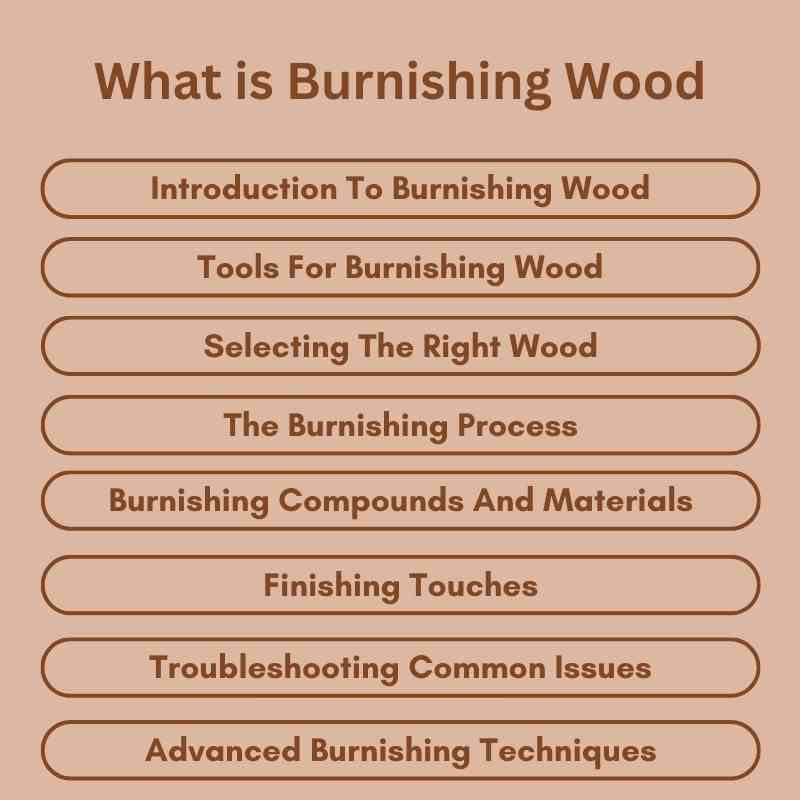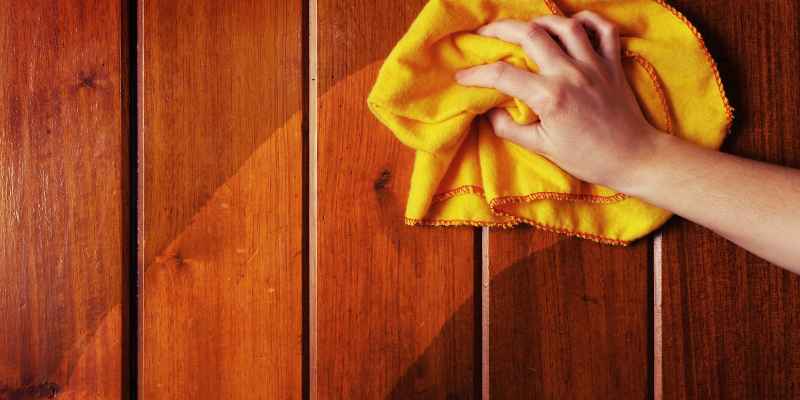Burnishing wood is a finishing technique that enhances the surface’s smoothness and sheen. This process involves rubbing the wood with a hard, smooth tool or abrasive.
Burnishing wood transforms rough surfaces into sleek finishes. Artisans often use this method to prepare wood for final coatings or to achieve a natural luster. The technique works by compressing the wood fibers, which reduces porosity and creates a polished appearance.
It’s popular in furniture making and fine woodworking, where aesthetics play a crucial role. Burnishing can be done with various tools, such as a burnisher or even a smooth cloth. This technique not only improves the wood’s look but also enhances its durability, making it a valuable skill for woodworkers and DIY enthusiasts alike.
Introduction To Burnishing Wood
Burnishing wood is a special technique used to create a smooth surface. It enhances the wood’s natural beauty. This method involves using friction to polish the wood. Unlike traditional sanding, burnishing does not remove material.
The art of wood finishing includes various techniques. Each method has its unique benefits. Burnishing stands out because it gives a glossy finish without chemicals. It also helps protect the wood.
Comparing burnishing to other techniques shows clear differences:
| Technique | Benefits | Drawbacks |
|---|---|---|
| Burnishing | Smooth finish, no chemicals | Requires practice |
| Sanding | Removes imperfections | Can damage wood |
| Staining | Adds color | May hide wood grain |

Tools For Burnishing Wood
Burnishing wood can be done with various tools. Traditional burnishers include items like a smooth stone or a hard wooden block. These tools create a shiny finish by rubbing against the wood surface.
Modern burnishing devices often use machines for faster results. They can provide a consistent finish and save time. Some devices even heat the surface to enhance the shine. Both traditional and modern options have their own benefits.
| Type | Benefits |
|---|---|
| Traditional Burnishers | Simple, inexpensive, and easy to use. |
| Modern Devices | Faster results and consistent finish. |
Selecting The Right Wood
Choosing the right wood species is crucial for burnishing. Some woods are better suited for this process than others. Hardwoods like oak, maple, and cherry work well. They provide a smooth finish and shine.
Softwoods like pine can also be burnished. They are easier to work with but may not shine as brightly. The key is to select high-quality wood for the best results.
| Wood Species | Characteristics |
|---|---|
| Oak | Strong and durable, great for burnishing. |
| Maple | Fine grain, easy to polish. |
| Cherry | Rich color, smooth finish. |
| Pine | Lightweight, easier to work with. |
Preparing wood surfaces is important before burnishing. Sand the wood to create a smooth base. Start with rough sandpaper, then switch to finer grit. This process helps achieve a brilliant shine.
The Burnishing Process
The burnishing process makes wood surfaces smooth and shiny. Start by preparing your wood. Ensure it is clean and free from dust. Use fine-grit sandpaper for an even surface. This helps in achieving the best results.
Next, choose a burnishing tool. A simple cloth or a specialized tool works well. Apply gentle pressure while moving the tool in circular motions. This helps create a beautiful shine on the wood.
Keep the tool dry. Moisture can damage the wood and reduce shine. After burnishing, inspect the surface. Look for any rough spots and repeat the process if needed. Lastly, apply a finishing oil to protect the wood and enhance its appearance.
- Start with clean wood.
- Use fine-grit sandpaper.
- Choose the right burnishing tool.
- Apply gentle pressure.
- Keep the tool dry.
- Inspect and repeat if necessary.
- Finish with oil for protection.
Burnishing Compounds And Materials
Burnishing wood involves using special compounds and materials. Both natural and synthetic options exist. Natural burnishing agents include oils and waxes. These are safe for the environment and easy to use.
Synthetic options are often more durable. They can provide a high-gloss finish that lasts longer. Choosing between them depends on your project needs.
Application techniques vary based on the type of burnishing agent. Use a soft cloth for natural compounds. For synthetic options, a buffer may work better. Always test on a small area first. This ensures the finish meets your expectations.
Finishing Touches
Burnishing wood creates a smooth, shiny finish. This process enhances the wood’s natural beauty. The technique involves rubbing the surface with a soft cloth. It can also use fine abrasives for better results.
Sealing the shine is essential to protect the wood. Use a suitable wood finish or sealant. These products prevent moisture damage and scratches. Regularly reapply the sealant to maintain the shine.
For maintenance and care, clean the surface with a soft cloth. Avoid harsh chemicals that can damage the finish. Keep the wood away from direct sunlight. This prevents fading and drying out.
Troubleshooting Common Issues
Dealing with imperfections during burnishing can be tricky. Adjust pressure and technique for better results.
Too much pressure can cause scratches. Use lighter pressure to avoid this problem. Test your technique on scrap wood first.
For uneven surfaces, change your angle. This helps the tool reach all areas. Smooth out the wood gradually.
Always check your tool condition. A dull tool can create more issues. Keep tools sharp for the best finish.
Advanced Burnishing Techniques
Burnishing wood creates smooth and shiny surfaces. This technique enhances the wood’s natural beauty. Different tools can produce artistic effects. For instance, using a soft cloth or a wooden block helps achieve unique textures.
Combining burnishing with other finishes gives wood a professional look. Applying a thin coat of oil before burnishing adds depth. It can also protect the wood from moisture and damage. Experimenting with different finishes allows for personal expression in wood projects.
Try mixing stains with burnishing for stunning results. This method can highlight the wood’s grain patterns. The interplay of colors creates a dynamic appearance. Always test on a small area first to see the effect.
Real-world Examples
Many woodworkers use burnishing to enhance the beauty of their projects. This technique creates a smooth finish that feels nice to the touch. Several case studies highlight the success of burnished wood pieces.
One case involved a custom dining table. The owner loved the rich color and smooth surface. Another project featured a handcrafted chair that stood out due to its glossy finish.
Many artists also display their burnished creations in galleries. These works often attract attention for their unique appearance and craftsmanship. Burnished wood can transform ordinary items into stunning focal points.
| Project Type | Outcome |
|---|---|
| Dining Table | Smooth, rich color |
| Handcrafted Chair | Glossy, eye-catching finish |

Frequently Asked Questions
What Does Burnishing Wood Mean?
Burnishing wood refers to the process of polishing or smoothing the surface of wood. This technique enhances the wood’s natural beauty and provides a sleek finish. It can be done using various tools, such as a burnishing tool or a cloth.
The result is a shinier, more refined appearance.
How To Burnish Wood Effectively?
To burnish wood effectively, first ensure the surface is clean and smooth. Use a hard, smooth tool, like a bone folder or a piece of hardwood. Apply consistent pressure and move in circular motions. This technique compresses the wood fibers, creating a glossy finish without the need for additional coatings.
What Tools Are Used For Burnishing Wood?
Common tools for burnishing wood include a burnishing tool, cloth, or even the edge of a hard object. A flexible burnisher or a smooth piece of hardwood works well. Each tool serves to compress the wood fibers, enhancing the finish.
Choose the tool based on your project needs.
Is Burnishing Wood Necessary?
Burnishing wood is not strictly necessary but offers several benefits. It improves the wood’s appearance by adding sheen and depth. Additionally, it can help protect the surface from dirt and moisture. For projects requiring a refined finish, burnishing is highly recommended to achieve professional results.
Conclusion
Burnishing wood enhances its natural beauty and durability. This technique creates a smooth, reflective surface that showcases the grain. It is an effective method for finishing furniture and crafts. By incorporating burnishing into your woodworking projects, you can achieve stunning results.
Embrace this timeless practice to elevate your craftsmanship.

